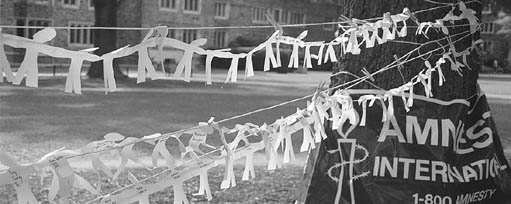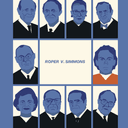
New York Times Condemns Capital Prosecution of Juvenile
A recent New York Times editorial criticized the federal government’s decision to designate Virginia as the first state to prosecute Washington, DC-area sniper suspect Lee Malvo. Juvenile defendants, including 17-year-old Malvo, are eligible to receive the death penalty in Virginia. The editorial, which chastised police for questioning Malvo outside the presence of his court-appointed guardian, sharply objected to the government’s manipulation to ensure that Malvo would be tried in a jurisdiction that permits juvenile death sentences:
There are good reasons the law treats juveniles differently. Young people do not have the same judgment as adults, they are less able to rein in their impulses and they are more susceptible to outside influences.
…
Mr. Malvo’s age, and the government’s desire to prevent it from playing a role in his prosecution, also appears to have been a key factor in choosing Virginia as the first state to prosecute the case.The biggest difference in the two states’ treatment of juveniles concerns the death penalty. Maryland does not execute juveniles, while Virginia has executed three since 1976 — the second-highest number of any state. It is Virginia that is out of touch: fewer than half the states now have the death penalty for juveniles, and only seven have executed one in the last 26 years. In choosing Virginia, the Justice Department appears, shamefully, to have forum-shopped for one of the country’s few jurisdictions with a penchant for putting minors to death.
The Bush administration … seems to be saying that if a crime is sufficiently notorious, time-honored legal protections for juveniles should be abandoned. But this nation is strong enough to prosecute criminals, internal and external, without giving up its principles.
(New York Times, November 12, 2002).

Virginia to Try Sniper Suspects First
Attorney General John Ashcroft has announced that Washington, DC-area sniper suspects John Allen Muhammad and John Lee Malvo (a juvenile) will be first tried in Virginia, where both could face the death penalty. Muhammad will stand trial in Prince William County, and Malvo will be tried in Fairfax County. (Associated Press, November 7, 2002). This decision uses federal authority to circumvent federal law, which forbids seeking the death penalty for juvenile offenders. In addition, almost every country in the world has ratified the international treaty banning the execution of juvenile offenders. For information about Virginia’s death penalty law and system of representation, see the Virginia ACLU death penalty report (download).

Inter-American Commission Concludes Nevada Juvenile Death Sentence a Violation of Human Rights
The Inter-American Commission on Human Rights recently issued a ruling in a case filed on behalf of Nevada death row inmate and juvenile offender Michael Domingues. The Commission, which is an arm of the Organization of American States, ruled that the execution of Domingues would be a violation of the American Declaration of the Rights and Duties of Man. The ruling stated:
[A]fter considering the merits of the case, the Commission concluded that the State has acted contrary to an international norm of jus cogens by sentencing Michael Domingues to the death penalty for a crime that he committed when he was 16 years of age. Consequently, should the State execute Mr. Domingues pursuant to this sentence, the Commission found that it will be responsible for a grave and irreparable violation of Mr. Domingues’ right to life under Article 1 of the American Declaration.
Michael Domingues v. United States, Case 12.285, at par. 5, Report No. 62/02, Inter-Am. C.H.R. (Oct. 22, 2002)

New York Times, Washington Post Urge Court to Revisit Juvenile Death Penalty
The New York Times and the Washington Post recently editorialized that the Supreme Court should revisit and ultimately put an end to the execution of juvenile offenders. (see below) The Washington Post observed that, “The juvenile death penalty…is one of the least defensible aspects of American capital punishment.” The paper noted that when deciding where to draw the line between those who will and will not receive the death penalty, “Distinguishing between legal childhood and adulthood seems a far more rational place to put it than between the sophomore and junior years of high school.” (Washington Post, October 23, 2002)
The New York Times noted:
As the dissenters correctly observed, the rationale that led the court to declare the execution of retarded people to be unconstitutional argues for revisiting the juvenile death penalty. In both instances there are profound questions of the defendants’ capacity to fully understand the consequences of their actions, and thus their level of culpability. (New York Times, October 24, 2002)
See also, Supreme Court.


Four Justices Signal Readiness to Consider Execution of Juvenile Offenders
Justices John Paul Stevens, David Souter, Ruth Bader Ginsburg, and Stephen Breyer called the execution of juvenile offenders a “shameful practice.” The Justices stated, “The practice of executing such offenders is a relic of the past and is inconsistent with evolving standards of decency in a civilized society.” (Associated Press, October 21, 2002). The Justices were dissenting from the Supreme Court’s refusal to consider direct relief for Kevin Stanford from Kentucky. Stanford’s petition was an unusual appeal, since he had previously exhausted the typical ways for obtaining relief. The four votes for taking this case would have been enough for the High Court to hear this issue if presented in an ordinary petition for certiorari. The temporary delay in deciding the juvenile execution issue gives states the opportunity to resolve it themselves. States could also stay the executions of juvenile offenders because of the likelihood that the Court will clear up this issue in the near future. Read the Supreme Court dissenting opinion.

Amnesty International Report Examines Juvenile Death Penalty in the United States
In a report released on September 25, 2002 titled “Indecent and internationally illegal: The death penalty against child offenders,” Amnesty International examines the juvenile death penalty in the United States. The report looks at the U.S. Supreme Court’s Atkins v. Virginia decision exempting prisoners with mental retardation from the death penalty and applies its reasoning to the issue of juvenile offenders. The report also provides a broad overview of the history of the juvenile death penalty through case reviews, international human rights policies, and recent developments around the world.

Photo by LINZY LUEBCHOW/THE CHRONICLE
Paper dolls, representing the number of people – about 800 – executed in the United States since the death penalty was reinstated in 1977, hang in front of the West Union Building as a silent protest of capital punishment. The display was organized by Amnesty International.

Arkansas Judge Calls for End to Execution of Juvenile Offenders
During an Arkansas panel discussion on the state’s death penalty, Pulaski County Circuit Judge Wiley Branton, Jr. compared the execution of juvenile offenders to the execution of those with mental retardation, a practice recently banned by the U.S. Supreme Court in Atkins v. Virginia. Judge Branton said, “To me, there’s not a whole lot of difference between a mentally incompetent adult and a child.”
Dr. Chris Lamps, an assistant professor of psychiatry at the University of Arkansas for Medical Sciences, said adolescents’ brains do not have the capacity to contemplate consequences as do most adults. “Children’s behavior is dominated by emotions,” Lamps noted. “They think with their emotions. And risk really isn’t a big part of making emotional decisions.” (Associated Press, September 19, 2002)


Three Supreme Court Justices Urge Consideration of Juvenile Issue
The August 28th execution of Texas juvenile offender Toronto Patterson marked the third time in four months that Texas has executed a black male who was sentenced to die for crimes committed as a juvenile. In response to Patterson’s appeal to the U.S. Supreme Court to stay his execution in order to consider whether the execution of juvenile offenders is cruel and unusual punishment, three Supreme Court Justices — Justices John Paul Stevens, Ruth Bader Ginsburg, and Stephen G. Breyer — said the Court should consider reviewing the death penalty for those who commit crimes before the age of 18. In his dissenting opinion, Justice Stevens wrote, “Given the apparent consensus that exists among the states and in the international community against the execution of a capital sentence imposed on a juvenile offender, I think it would be appropriate for the court to revisit the issue at the earliest opportunity.” (Washington Post, August 29, 2002)
Earlier this month, former first lady Rosalynn Carter called for a national moratorium on executions and an end to the execution of juvenile offenders.

Juvenile Offenders on Pakistan’s Death Row Get Life Sentence
As Pakistan’s federal government enforces the Juvenile Justice System Ordinance 2002 in Punjab, 74 juvenile offenders had their death sentences converted to life imprisonment, according to Punjab Law Minister Rana Ijaz Khan. (Pakistan News, July 25, 2002.) According to the American Bar Association, in the last three years, the number of nations that execute juvenile offenders has dropped significantly to only three: Iran, the Democratic Republic of Congo, and the United States. See also International Death Penalty.

Execution of Juvenile Offender Scheduled in Missouri
Chris Simmons, who was scheduled to executed in Missouri on June 5,received a stay of execution from the U.S. Supreme Court. Simmons, a 17 year-old high school student at the time of the crime, was under the influence of drugs and alcohol and was also found to be suffering from schizotypal disorder, a mental illness. At trial, Simmons’ attorney failed to present evidence of this mental disorder or evidence of Simmons’ childhood abuse by his father. (Missourians to Abolish the Death Penalty, Action Alert, 4/13/02) Currently, there are 83 juveniles on death row across the U.S., and 2 on death row in Missouri. Since the death penalty was reinstated, Missouri has executed one juvenile offender. See also the American Bar Association Juvenile Justice Center’s Web page on the Simmons case.

Chris Simmons

Indiana Bars Execution of Juvenile Offenders
Indiana became the 16th state to forbid the death penalty for those who were under 18 years-of-age at the time of their crime. Gov. Frank O’Bannon signed SB 426 on March 26. The law also requires judges to follow juries’ unanimous sentencing recommendations. (Associated Press, 3/26/02.) Federal death penalty law similarly excludes juvenile offenders. An additional 5 states restrict the death penalty to those who are at least 17 at the time of their crime.

Georgia Board of Pardons and Paroles Commutes Sentence to Life
Alexander Williams was granted clemency by the Georgia Board of Pardons and Paroles on February 25. A spokeswoman for the Board stated that Williams’s mental illness, his status as a juvenile offender, and his history of abuse as a child were factors leading to the Board’s decision to commute his death sentence to life without parole. The Board received many pleas for clemency, including those from the United Nations Commission on Human Rights, the European Union, the American Bar Association, and former First Lady Rosalynn Carter. (New York Times, 2/26/02) This was the second death penalty granted this year and the 48th since 1976. See also, Clemency.

Prominent Organizations Oppose Execution of Mentally Ill Juvenile Offender in Georgia
Alexander E. Williams, a juvenile offender who suffers from paranoid schizophrenia, is scheduled for execution in Georgia on February 20 (stayed until at least Feb. 25). The Georgia Board of Pardons and Paroles has received pleas for clemency for Williams from organizations and individuals such as the American Bar Association, former First Lady Rosalynn Carter, the European Union, the National Alliance for the Mentally Ill, and the National Mental Health Association.
Williams’s trial lawyer failed to present available mitigating evidence to the sentencing jury, including the fact that Williams suffers from severe mental illness, and that his childhood was plagued with chronic physical, sexual, and emotional abuse. Five of the eight living jurors from his original trial have signed affidavits stating that they would not have sentenced Williams to death if they had known about his history of abuse and mental illness. (ABA Juvenile Justice Center, Action Alert, 2/13/02)
To read a selection of clemency appeals and news articles written about Williams’s case, see ABA Juvenile Justice Center. See also, Amnesty International’s report “USA: Crying out for clemency.”
Currently, legislation to ban the execution of juvenile offenders is pending in Arizona, Florida, Indiana, Kentucky, and Missouri.



